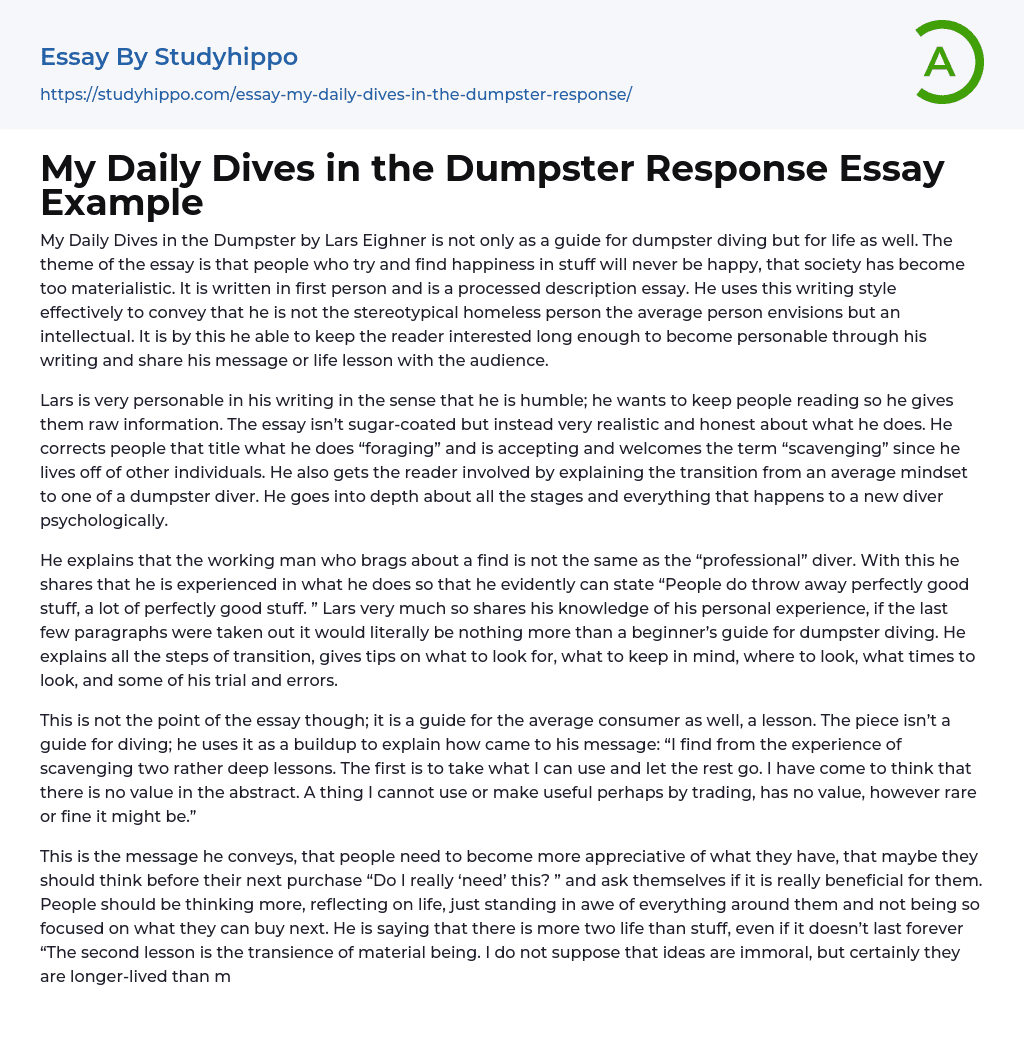My Daily Dives in the Dumpster by Lars Eighner is not only as a guide for dumpster diving but for life as well. The theme of the essay is that people who try and find happiness in stuff will never be happy, that society has become too materialistic. It is written in first person and is a processed description essay. He uses this writing style effectively to convey that he is not the stereotypical homeless person the average person envisions but an intellectual. It is by this he able to keep the reader interested long enough to become personable through his writing and share his message or life lesson with the audience.
Lars is very personable in his writing in the sense that he is humble; he wants to keep people reading so he gives them raw i
...nformation. The essay isn’t sugar-coated but instead very realistic and honest about what he does. He corrects people that title what he does “foraging” and is accepting and welcomes the term “scavenging” since he lives off of other individuals. He also gets the reader involved by explaining the transition from an average mindset to one of a dumpster diver. He goes into depth about all the stages and everything that happens to a new diver psychologically.
He explains that the working man who brags about a find is not the same as the “professional” diver. With this he shares that he is experienced in what he does so that he evidently can state “People do throw away perfectly good stuff, a lot of perfectly good stuff. ” Lars very much so shares his knowledg
of his personal experience, if the last few paragraphs were taken out it would literally be nothing more than a beginner’s guide for dumpster diving. He explains all the steps of transition, gives tips on what to look for, what to keep in mind, where to look, what times to look, and some of his trial and errors.
This is not the point of the essay though; it is a guide for the average consumer as well, a lesson. The piece isn’t a guide for diving; he uses it as a buildup to explain how came to his message: “I find from the experience of scavenging two rather deep lessons. The first is to take what I can use and let the rest go. I have come to think that there is no value in the abstract. A thing I cannot use or make useful perhaps by trading, has no value, however rare or fine it might be.”
This is the message he conveys, that people need to become more appreciative of what they have, that maybe they should think before their next purchase “Do I really ‘need’ this? ” and ask themselves if it is really beneficial for them. People should be thinking more, reflecting on life, just standing in awe of everything around them and not being so focused on what they can buy next. He is saying that there is more two life than stuff, even if it doesn’t last forever “The second lesson is the transience of material being. I do not suppose that ideas are immoral, but certainly they are longer-lived than material objects.”
Lars is teaching
people that they need to let go of their materialistic behaviors because they will never find happiness that way. He states that yes he’d be happier with a consumer life but his effort is rewarded daily and he is content with his life. He knows there will always be enough out there for him, it is the shoppers that constantly want more that he pities, they can’t fill the void of happiness with objects. So he closes with “Between us and the rat-race millions who have confounded their selves with the objects they grasp and who nightly scavenge the cable channels looking for they know not what. I am sorry for them”.
- Age Of Enlightenment essays
- Ethos essays
- Time essays
- Acceptance essays
- Meaning Of Life essays
- Reality essays
- Natural Law essays
- Political Philosophy essays
- Utilitarianism essays
- Existence essays
- Free Will essays
- Good And Evil essays
- Confucianism essays
- Relativism essays
- Conscience essays
- Environmentalism essays
- Empiricism essays
- Epistemology essays
- Ethics essays
- Existentialism essays
- Human Nature essays
- Individualism essays
- Metaphysics essays
- Philosophy Of Life essays
- Transcendentalism essays
- Truth essays
- Destiny essays
- Determinism essays
- Fate essays
- Functionalism essays
- Philosophers essays
- Pragmatism essays
- Future essays
- Child Observation essays
- Critical Reflection essays
- Teaching Philosophy essays
- Personal Philosophy essays
- Action Speak Louder Than Words essays
- Can Money Buy Happiness essays
- Values of Life essays
- Ethical dilemma essays
- Normative Ethics essays
- Virtue Ethics essays
- Belief essays
- Deontology essays
- Moral essays
- Virtue essays
- Work Ethic essays
- Henry David Thoreau essays
- Carl Jung essays




